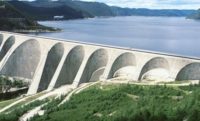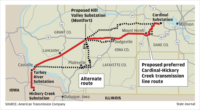A$2.5-billion power transmission project to carry Midwest renewable energy to East Coast markets—once considered an industry joke—now has the backing of two large energy investors, Siemens AG and Copenhagen Infrastructure Projects (CIP). The U.S. Fish & Wildlife Service calls it “precisely the kind [of project] the U.S. needs to build out.”
Jingoli Power, construction manager and a partial owner, has supported the SOO Green Renewable Rail project for seven years, says CEO Karl Miller. “I’ve gone into a lot of meetings where people said, ‘You guys are crazy,’ ” he says.

The project, named for Canadian Pacific Railway’s Soo line, would run an underground high-voltage direct current transmission line along 349 miles of the rail firm’s existing U.S. track, from Mason City, Iowa, to near Chicago. Right-of-way is in place for about 85% of the route.
Developers hope to have the project on line in 2024. The transmission is needed to move mostly wind power from key Midwest generation sites to eastern U.S. population centers. Right-of-way issues have bogged down other transmission projects using overhead lines.
In the SOO Green model, wind generators would feed power into MISO, the transmission system serving the Midwest. SOO Green would pull power from MISO in Iowa and link it with PJM Interconnection, the largest U.S. transmission system, at an Exelon site in Illinois. PJM supplies regional power north from Virginia to New Jersey and west to Illinois. “We are at a point where the technology exists to have the line underground,” says a project spokeswoman.
Three components have linked to make the project viable: elimination of eminent domain to secure right-of-way; development of flexible high voltage 525-kV XLPE cable that can be placed underground; and Siemens Energy’s high capacity HVDC Plus voltage source converter technology. The latter is “pushing the boundaries of transmission and physics,” says Orestes Macchione, the firm’s HVDC business developer. At 2,100 MW, the project would be the most powerful U.S. high-voltage line, he says.
The SOO Green transmission model can be replicated elsewhere and will boost wind farms, says Macchione. Developer Direct Connect Development Co. also is able to use more Canadian Pacific rail for future expansion, Macchione says. Navigant, a project consultant, expects more than 4 GW of wind to come online in Iowa, Minnesota and the Dakotas by 2023. Siemens’ voltage source converter will take energy from MISO’s grid and convert it from AC to DC and back to AC at the other end, with only 4% power loss.

Unlike classic converter technology that uses thyristors with limited function, the Siemens model has transistors that can control power in a smart way, says Macchione. The state-of-the-art converter has more tools available for conversion and works well in areas without much infrastructure and with constantly changing wind. The technology increases grid stability and stabilizes voltage and frequency to avoid failures common with classic converters, he says. It also has the ability to “black start,” or repower the grid in a simple way, according to Macchione.
Siemens, which is responsible for the engineering, manufacture, installation and commissioning of converter stations, has used them to transmit power from North Sea offshore wind farms to Germany. “This project has the potential to transform how energy is delivered in the U.S. and around the world,” a spokeswoman says. Siemens and CIP will own noncontrolling interests in the project, of undisclosed size, officials say. Underground construction will cost less and streamline permits for the route, which includes boring under the Mississippi River and in other sensitive habitats, but materials will be more expensive, says Miller. Ecology and Environment and Power Engineers are project consultants.
Two 8-in. PVC conduits will be buried about 5 ft deep on 2.5 ft of railroad right-of-way. The 5-in.-dia cable will be pulled through the conduit later and spliced together. Connections between the lengths of cable will be key, says Miller. The project will hire about 600 workers for construction. While he says the project “footprint is very, very small,” Miller plans to consult with every landowner whose property abuts the railroad easement to ensure safety. “No one will cross the rails,” he says.





Post a comment to this article
Report Abusive Comment